Osteochondrosis is a common pathology of the spine, which is characterized by a dystrophic change in the structure of the cartilage slices of the vertebrae and its bone base.
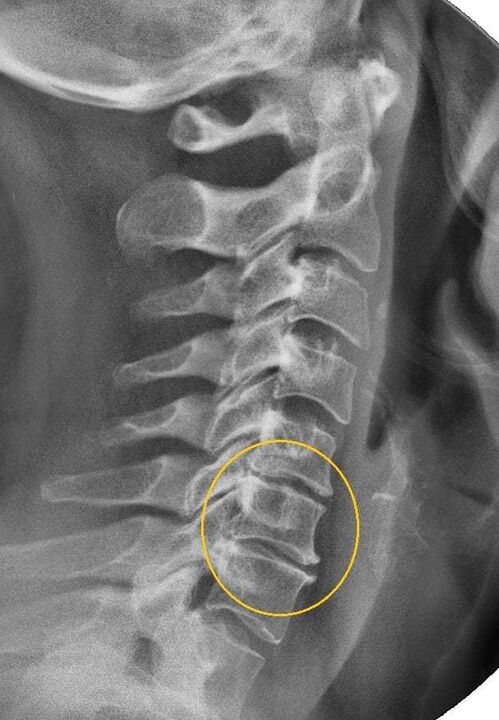
In most people, osteochondrosis manifests themselves in most people after 30 years. The symptoms of cervical osteochondrosis are diverse, which often complicated the diagnosis and subsequent treatment.
The causes of cervical osteochondrosis
Partly in the development of the osteochondrosis of the neck "guilty", the upset of the modern person and the corresponding distribution of loads along the spine and the natural processes of aging the body tissue. There are also a number of the development and progress of this pathology:
- sitting lifestyle;
- long stay in the same position during work;
- excess body weight;
- persistent injuries to the spine in the neck;
- Chronic stress, constant nervous tension;
- Regular hypothermia of the muscles of the collar zone (for example, if it is near the air flow from the air conditioning);
- Congenital vertebra anomalies and intervertebral discs.
General symptoms and signs of cervical osteochondrosis
The osteochönig process influences one of the spine or several at the same time. The lumbar and cervical vertebrae are most affected by pathologies that are most susceptible to loads due to the anatomy of the human skeleton.
The consequences of osteochondrosis in the spine in the cervix region cause the greatest inconvenience and potential complications because the neck is an area that is rich in neuromusive motorways, many of which directly feed the brain.
For this reason, clinical symptoms with cervical osteochondrosis are connected to the ischemia of brain areas. In addition, the nerve roots that provide the sensitivity and motor activity of the hands and shoulder girdle, a variety of symptomatic image when pressing with destroyed vertebrates.
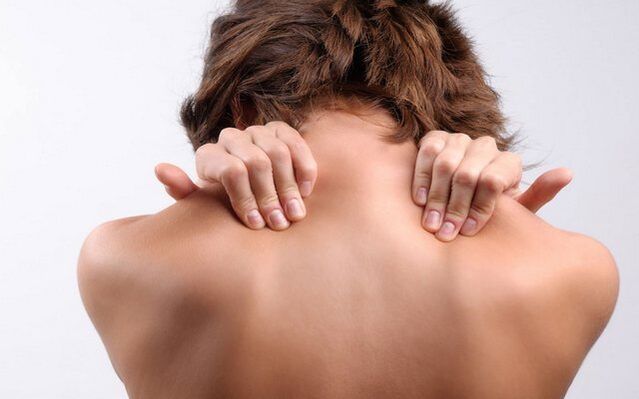
Signs of a neck osteochondrosis depend on which of the body systems are influenced by the pathology:
- Disturbed blood circulation due to the compression of the vertebral arteries determined most symptom complexes from the brain.
- The compression of the roots that leave the vertebrate gives a picture of the lesion of the peripheral nerves.
- Inclosing spinal cord areas is associated with severe neurological pathologies that have been found in advanced cases.
Note the general clinic of the osteochondrosis of the cervical spine below.
Pain in the back of the head, neck and collar area
This is the most common symptom. The localization of pain can be expanded, which affects the shoulders, the collarbone region, the chest and intensive head migraine.
The type of pain depends on the localization of the lesion and the severity of the pathology. First of all, the pain can quickly be temporary and gradually become chronic and painful.
In moments of deterioration, the pain will shoot with an increased tone of the neck muscles and a limited movement of the head.
Pain with cervical osteochondrosis can often be localized behind the star. In this case, many patients occupy this symptom for angina pectorator. The differentiation can be carried out by taking a pill nitroglycerin - the pain due to osteochondrosis, they are not removed.
Must, ringing, damned in the ears
These symptoms often follow to decrease in hearing. These phenomena are associated with a decrease in blood flow from the vertebral arteries to the vestibular apparatus.
The complex of these symptoms is referred to as cochlea or snail syndrome, and it is anything but always possible to determine the connection with osteochondrosis in the cervix region.
A specific feature for differentiation is that noise, traffic jams and ringing can be felt in the ears after a long stay in a position.
dizziness
Dizziness is also due to a violation of the blood flow against the organs of the inner ear, which ensures the body's balance. Nystagm often combines dizziness - arbitrary fluctuations in the eye pupils on the sides.
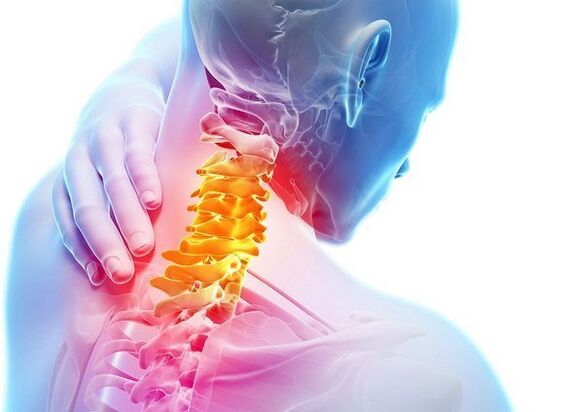
Lack of air
This sensation appears due to the irritation of the ends of the diaphragm. It is part of the nerve beam in the cervix and is involved in the regulation of breathing, its depth and frequency. The patients complain about the inability to breathe in full chest.
In some cases, the symptom exacerbates severe shortness of breath and suffocation. For the same reason, breathing stops at night and snoring.
The disadvantage of oxygen due to breathing problems is ultimately the cause of increased fatigue, a decrease in concentration and memory problem.
Trimming
It is accompanied by the air air. Also due to problems with blood circulation in some areas of the brain and inner ear. Nausea is sometimes observed with indomitable vomiting, which are provoked by movements of the head and body. The consequence of frequent nausea and vomiting is a decrease in appetite, weight loss and digestive failure.
Problems with seeing
"Fly" in the eyes, a decrease in visual acuity, fog in front of the eyes - these are all symptoms due to the ischemia of the brain area responsible for seeing.
Patients with osteochondrosis are less likely to complain because the lack of blood supply is compensated for by the vertebral houses by blood flow from the carbon artery system.
Glasses and therapeutic gymnastics for the eye muscles do not solve the problem, usually seeing improves after the treatment of osteochondrosis.
Blood pressure
An unstable level of pressure is due to an impaired blood flow in the long brain, which is responsible for the functions of the vascular motor center.
Sudden fainting or syncopal states
It occurs with a cramp of the brain's arteries due to the short -term termination of blood flow along the vertebral arteries.
From the condition of the loss of the patient's consciousness, they can be removed quickly by laying it a little higher than the head - the blood flow to the brain enables a person to live to life.
After a fainting, reversible problems with language and movements can be observed for some time due to a short blood flow.
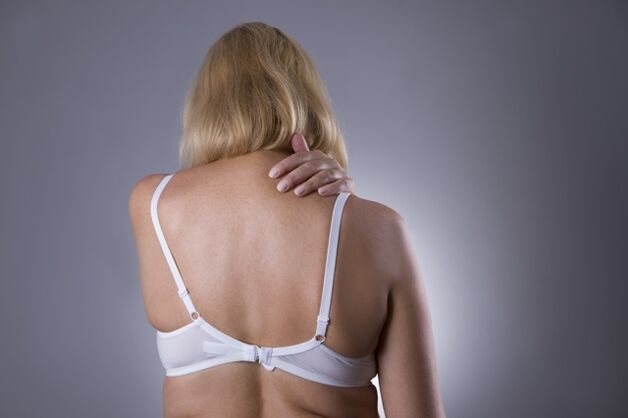
Green symptoms
It can often be the only sign that indicates the cervical osteochondrosis. They are expressed as sweat, dryness and feeling of a clud in the throat and difficulties when swallowing. The symptoms are connected to the compression of the nerve plexus, which is responsible for the innervation of the pharynx. It is necessary to distinguish such manifestations from a similar clinic for inflammation or neoplasms.
Increase body temperature
The increase in body temperature for cervical osteochondrosis is not the most typical symptom, it is rarely and locally observed: in the cervical and collar area with a slight reddening of the skin.
The osteochondrosis clinic in the cervical spine can initially be different severity of the severity. Even in times of deterioration, they are brighter and second to form in certain syndromes.
Symptoms depending on the stage of the cervical osteochondrosis
Level I
The beginning of the degenerative processes in the cartilage of the vertebral slices. The symptoms are weak, sometimes it cannot be observed at all. The first signs of an osteochondrosis of the cervical spine:
- Complaints in the neck, arms, shoulders, sometimes pain;
- Headache;
- simple restriction of the motor activity of the neck;
- fast temporary visual impairment;
- Reduction of the sensitivity of the skin of the collar area.
Important: These symptoms are more pronounced when tipping the head.
As a rule, the patients do not go to the doctor in the first stage of osteochondrosis of the cervix region, and believe that all symptoms are associated with fatigue, stress, age, lack of sleep.
Level II
At this stage, the vertebrate's lead began, the band fire cracks Schmal, the collagen fiber of the fiber ring of the disc is destroyed. Due to the compression of the nerve trunks, which intensifies during the neck movements and the head change, there are noticeable painful symptoms of a point in nature. Here you can already suspect the cervical osteochondrosis, the symptoms of which are as follows in the second stage:
- pronounced pain in the neck, sometimes with a crunch;
- The skin of the shoulders and hands almost completely loses sensitivity;
- Headaches are common, do not happen long;
- Visual impairment with "flying" in the eyes;
- Ringing and noise in the ears;
- Weakness of the muscles of the upper extremities;
- The clarity of the tendon reflexes is reduced;
- Pain with dedication under the shoulder blade;
- The feeling of a lump in the throat, problems with swallowing;
- Sleep disorders, usually insomnia.
Holding the head long in a position leads to severe pain. At this stage of the development of the disease, patients are already coming to the doctor to receive help.
Level III
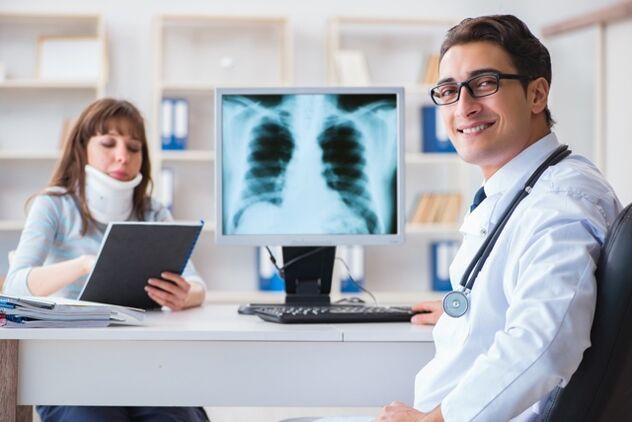
The fibrous ring in the window is destroyed, hernia are formed. In the third stage, due to its weak fixation, there is a deformation of the spine, shift and transfers of the vertebrae. The symptoms are as follows:
- Intensive, acute pain in the neck, collar zone, heart area;
- the sensitivity of the scalp on the back of the head, in the shoulder region, in the hands to complete absence;
- Hernia of the cervical spine;
- Parese and paralysis of the upper extremities;
- Tendular reflexes are practically not observed.
This is a serious stage of the disease in which the patient can no longer support his head himself. The ischemia of the spinal cords and the compression of the spinal arteries lead to paralysis and paresis in other parts of the body and in the spine line.
Syndromes caused by osteochondrosis of the cervical spine
Non -specific and a large number of different symptoms that accompany the osteochondrosis of the cervical spine, it is difficult to diagnose diagnosis and further treatment, since some of them can be a sign of completely different diseases. Symptoms of cervical osteochondrosis are formed in certain groups called syndromes. Their existence and heaviness can indicate a pathology in the cervical spine with an updated localization.
A group of frequently found syndrome:
Koreshka. Otherwise, called cervical radiculitis. It combines the symptoms associated with the violation of the nerve roots of the cervical vertebrae. The "goosebumps" in the affected area, which spread to certain fingers in fingers, forearms and the sharpness of the skin, are characteristic.
Iriture reflex. Burning and acute pain in the back of the head and neck, sometimes with the return to the chest and shoulder, which occurs at the time of changing the position of head and neck while sneezing, coughing and a sharp turn of the head.
The vertebrae syndrome includes:
- Headache, fighting or constantly pulsating in nature;
- Complaints in some movements, including a long static position;
- Weakness, nausea, loss of consciousness;
- Reduction of hearing, problems with balance;
- Reduction of visual acuity.
Heart. Almost the same picture with angina pectoris often leads to improper diagnosis and treatment. The syndrome appears due to the irritation of the receptors of the diaphragm, which partially fascinates the pericardous and a large chest muscle. Therefore, cramps in the heart region are reflexors, as checking the irritation of the cervical nerves. Symptoms:
- Suddenly longer pain began, tightened with a sharp movement of the neck, cough, sneezing, not when taking heart medication.
- The EKG shows no impaired blood flow of the heart muscle.
- Sometimes there is an extra -free and tachycardia.
Vegetative-diabolical syndrome. Subbluxus The first vertebrae of the cervix departure with a shift can lead to the development of a Vegeto-vascular dystonia. It is not a certain diagnosis of VVD because it has no pronounced symptoms.
Neurological signs, symptoms of an impaired cerebral blood flow, the intracranial pressure, can give muscle cramps.
As a result, the patient's symptoms, a decrease in visual acuity, the loss of consciousness, headache and nausea are due to a decrease in visual acuity.
How to treat cervical osteochondrosis
The described state of the spine is a very serious pathology that leads to disabilities with neglect and due to deep disorders of brain circulation and death. For this reason, you should not.
Osteochondrosis is treated exclusively as a prescription from a doctor in a hospital and at home.
In the first stages, the treatment of cervical osteochondrosis is conservative, including drug prescriptions: non -steroidal anti -inflammatory medication, anesthetics, hormonal medication, vitamin complexes, chondroprotectors -all this relief, pain, improves the trophies of softness and nori lines.

During the acute time, medication in the form of injections is prescribed because the patient declines that the patient goes to tablets. Physiotherapy, massage, exercises that are normally prescribed in the remission stage, join the drugs. In difficult cases, osteochondrosis is treated with surgery.
prevention
The basis for the health of the cervical spine is a strong and healthy back, physical activity, a comfortable bed with anatomical pillows and mattress, correct posture and correct nutrition.
It is worth avoiding neck injuries and lifting weight. It is necessary to combine a longer sitting with rest and warm -up.
Prognosis of Restoration
The forecast for qualified and timely treatment is cheap, but depends on the age of the patient, the severity of manifestations and the stage of the disease. It is also important that the person eliminates medical recommendations in terms of nutrition, lifestyle and bad habits.
Diploma
In most cases, an osteochondrosis of the cervix region can be healed. However, it is worth remembering that the disease can return at any time. To prevent this, it is necessary to observe prevention measures and a healthy lifestyle.
It is also remembering to remember:
- The cause of osteochondrosis is difficult to establish.
- The symptom of the disease is pain in the back of the head and neck.
- The cervical osteochondrosis is treated comprehensively: medication (mainly NSAIDS), massages, training therapy.

























